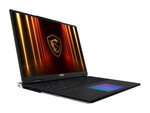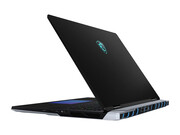MSI Titan 18 HX AI A2XWIG
Specifiche tecniche

Fotocamera Principale: 2 MPix
Price comparison
Media dei 3 punteggi (dalle 4 recensioni)
recensioni per MSI Titan 18 HX AI A2XWIG
Sorgente: PC Mag
 EN→IT
EN→ITMSI’s Raider 18 HX AI is the King Kong of gaming laptops: an unapologetically massive machine with powerhouse performance. It bristles with the latest technology, from Thunderbolt 5 to PCIe 5.0, but its standout feature is the stunning mini-LED display, which borders on unbelievable. It’s not flawless—noisy cooling fans, a largely plastic lower half, and a merely average keyboard trim off that fifth star—but when it comes to gaming, the Raider delivers in spades. That’s why it earns our Editors' Choice award among big-screen gaming rigs.
Singola recensione, disponibile online, Lungo, Data: 07/19/2025
Valutazione: Punteggio totale: 80%
Sorgente: Think Digit
 EN→IT
EN→ITEvery once in a while, a gaming laptop shows up that skips the whole subtlety thing and just screams performance. The MSI Titan 18 HX AI is that machine for 2025. With a 24-core Intel Core Ultra 9 285HX, Nvidia’s top-tier RTX 5090 GPU, 64GB of DDR5-6400 RAM, and 6TB of PCIe Gen 5 storage in RAID 0, it doesn’t pretend to be reasonable, and that’s the point. But in a market moving toward thinner, smarter machines like the ROG Strix Scar 18 and Alienware m18, you have to wonder: is there still room for a laptop this massive? Or is the Titan now just a flex for the few who need (or want) everything, all at once? To put it through its paces, I also paired the Titan with a bunch of Thunderbolt 5 accessories, from ultra-fast SSDs to hubs and cables, to see how far the new port standard can stretch when it’s backed by a system this powerful.
Singola recensione, disponibile online, Medio, Data: 07/14/2025
Valutazione: Punteggio totale: 76% prezzo: 47% prestazioni: 96% qualità di lavorazione: 76%
Sorgente: El chapuzas Informatico
 ES→IT
ES→ITSingola recensione, disponibile online, Lunghissimo, Data: 10/13/2025
Sorgente: Geeknetic
 ES→IT
ES→ITSingola recensione, disponibile online, Lunghissimo, Data: 06/12/2025
Valutazione: Punteggio totale: 93%
Commenti
NVIDIA GeForce RTX 5080 Laptop: Una scheda grafica veloce della famiglia Blackwell per computer portatili che si basa sul chip GB203 e utilizza 8.192 shader e 16 GB di memoria grafica GDDR7 (bus grafico a 256 bit).
Queste schede grafiche sono paragonabili alle entusiasmanti schede grafiche desktop, come la 9800M GT. Le schede hanno un core simile alle relative schede desktop, ma hanno un clock inferiore e spesso hanno processori con meno ombre. I giochi moderni come Age of Conan, Race Driver Grid, Call of Duty 4, Mass Effect, o Gothic 3 dovrebbero scorrere in modo fluido con dettagli elevati (Crysis dovrebbe funzionare con dettagli medio alti).
>> Ulteriori informazioni le potete trovare nel nostroConfronto delle schede grafiche e nella nostra Lista dei Benchmark.
Ultra 9 285HX: CPU mobile di fascia alta per notebook da gioco basata sull'architettura Arrow Lake. Offre 24 core composti da 8 core ad alte prestazioni con velocità di clock fino a 5,5 GHz e 16 core di efficienza minore con velocità di clock fino a 4,6 GHz. La CPU può accedere a 40 MB di cache L2 e 36 MB di cache L3 ed è specificata con un TDP di 55 watt. Il SoC integra una piccola NPU dedicata chiamata AI Boost con 13 TOPS (Int8) e supporta opzionalmente vPro Enterprise.
>>Ulteriori informazioni le potete trovare nel nostroConfronto dei processori per portatili.




